The Dutch side Ajax take on the champions of England Liverpool in the first round of UEFA Champions League. Both sides have displayed historic presence and competence in the European competitions. This year they sit along with the Italian side Atalanta and Denmark champions Midtjylland in group D, making the group very interesting from the tactical standpoint.
Liverpool haven’t had much luck starting off the new campaign. The embarrassing 7-2 defeat at Villa Park and the early injuries of Alisson Becker and Virgil Van Dijk have been their talking points so far. A win against the Dutch side was certainly a good boost for their morale.
Ajax failed to clinch the title last season due to the pandemic but it won’t deter their ambitions for this season. Despite losing key players in recent years, Erik ten Hag has maintained the Ajax philosophy to compete in all tournaments. They are currently second in the league table with just one point behind PSV.
In this tactical analysis, we will dissect the match events to understand the tactics of both sides. The analysis will therefore give a clear understanding of how the match unfolded.
Line-ups
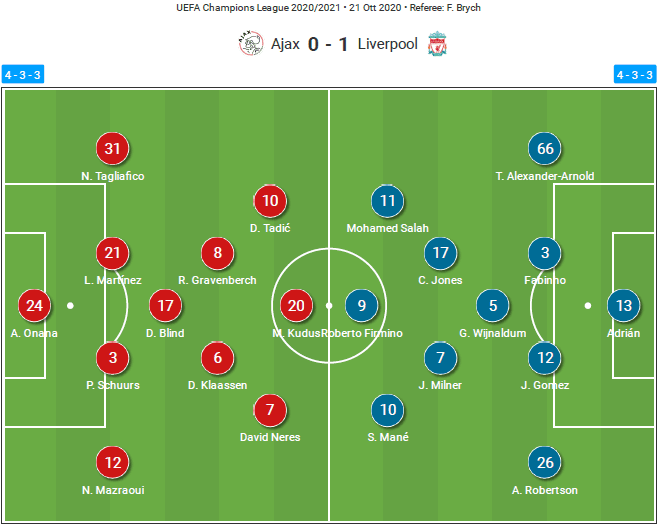
Ten Hag set-up his side in 4-3-3 for this match. Andre Onana played between the sticks with Noussair Mazraoui, Perr Schurrs, Lisandro Martínez and Nicolas Tagliafico forming the back-line. Former Manchester United player Daley Blind anchored the midfield. He was joined by Davy Klaassen and Ryan Gravenberch. Dusan Tadić and David Neres were deployed on the wings while the versatile Mohammed Kudus was used as a centre-forward for the match. Unfortunately, he got injured early in the match and Quincy Promes replaced him. The substitute caused Tadić to take the central role as Promes played on the left-wing.
Liverpool started in their usual 4-3-3 formation. Adrián was in charge of protecting the goal in the absence of Alisson. Fabinho had to fill in for injured Joel Matip and Van Dijk alongside Joe Gomez. They sat between the preferred full-back pair of Trent Alexander-Arnold and Andy Robertson. Jürgen Klopp handed Curtis Jones his first start in the Champions League, he joined James Milner and Gini Wijnaldum in the midfield. The front three of Mohamed Salah, Roberto Firmino and Sadio Mané was not new to anyone. Thiago Alcântara was another notable absentee from the squad due to injury.
Liverpool’s build-up against Ajax’s press
Closing the central channel
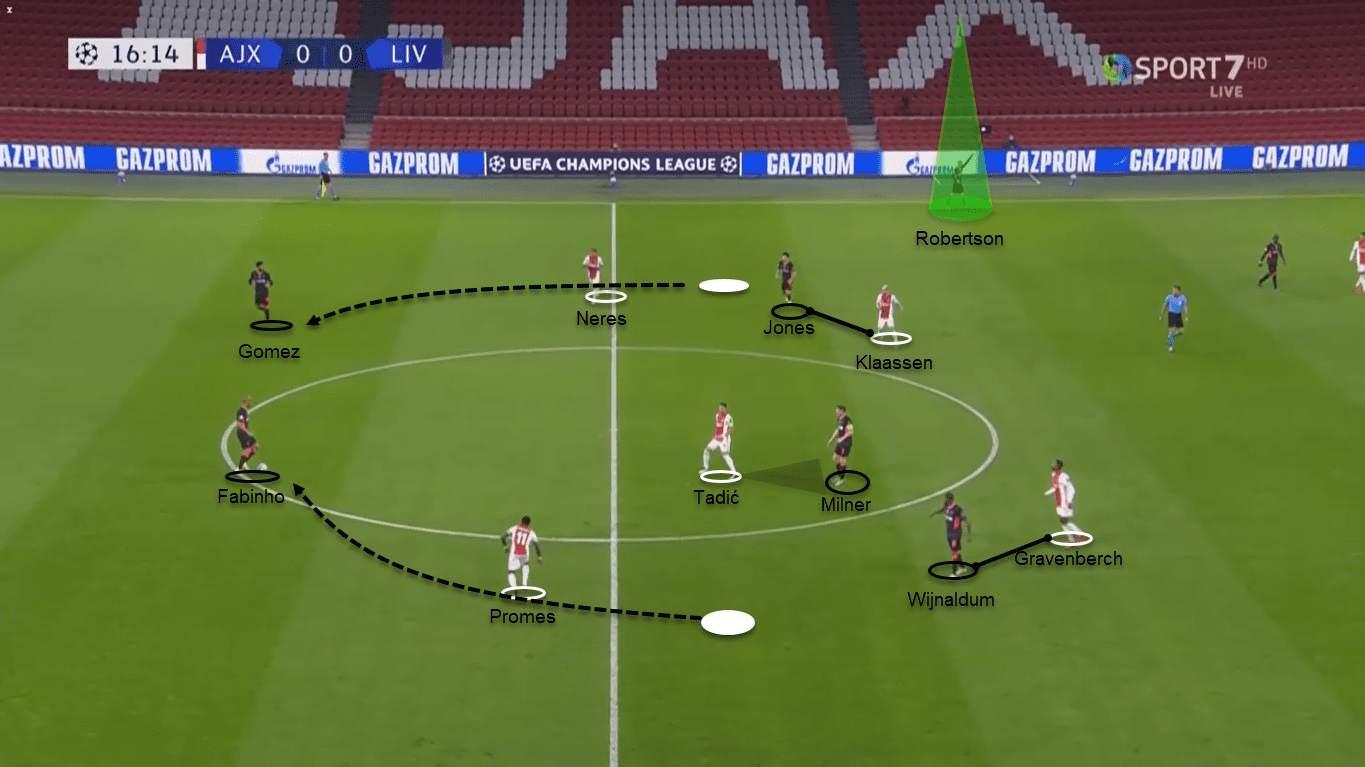
Ajax had studied their opposition very well to formulate their pressing. They understood the importance of Liverpool’s pivot and Firmino in ball progression. Since Fabinho was playing as a centre-back and Henderson didn’t start the match, Wijnaldum played as the pivot. While he is a regular name in Klopp’s eleven, he doesn’t exhibit the same qualities as Fabinho and Henderson in that position. He was covered by Tadić very closely throughout the match, either by man-marking him or shadowing him to completely eliminate him as a passing option. Blind was man-marking Firmino and tracked him around the entire pitch. Due to this rigid marking, the central channel was completely blocked for Liverpool.
Klaassen and Gravenberch man-marked Milner and Jones in the build-up phase too. The threat of Salah and Mané’s pace was evident, therefore Ajax’s back four stayed narrow to cover the two. Neres and Promes stayed between the full-backs and centre-backs. They pressed their respective side’s centre-back by making an outside-inside movement in order to cover shadow the full-back. This was either followed by a back pass to the goal-keeper or a long pass to the full-backs as those were the only players left unmarked by Ajax.
Setting the pressing traps
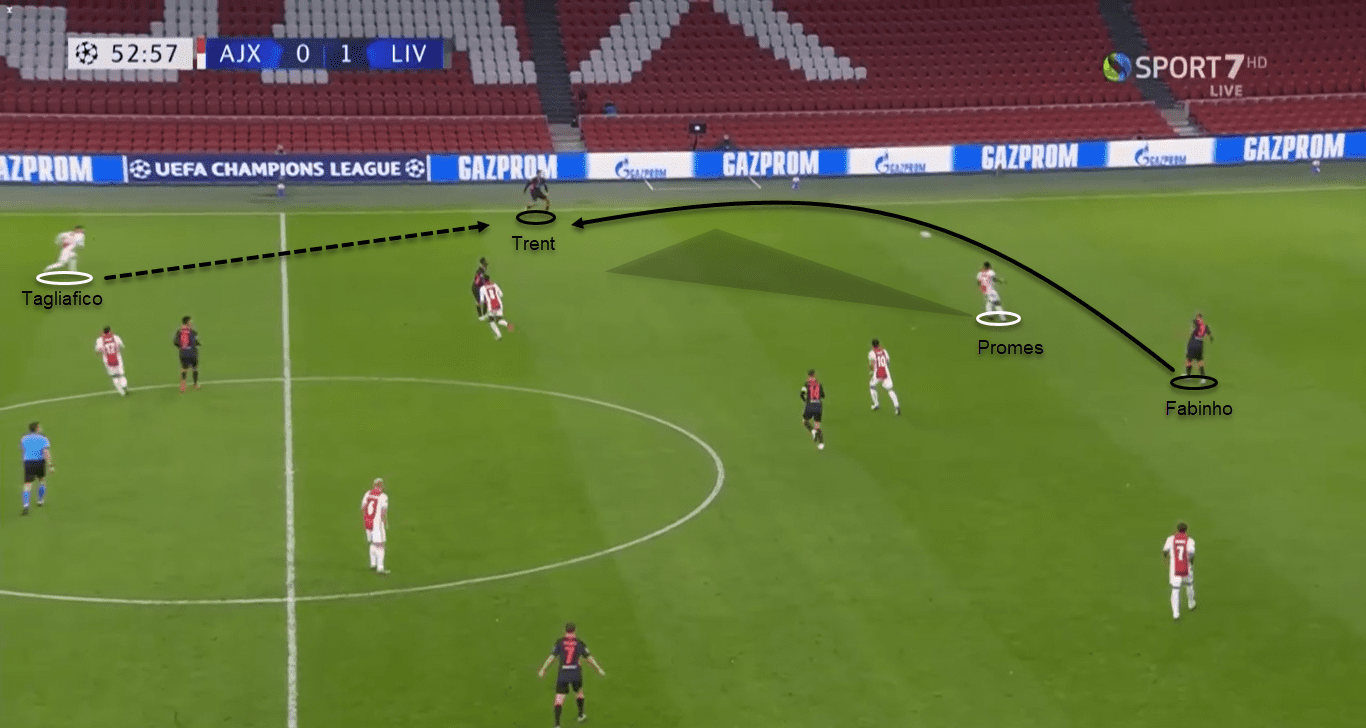
Ajax’s full-backs Tagliafico and Mazraoui were instructed to press Alexander-Arnold and Robertson as soon as the ball was played towards them. As those were the only two unmarked players, Ajax was always prepared for that pattern of play. Neres and Promes’ cover shadowing ensured that the only way the full-backs received the pass was from an airball. It is more time consuming to get an airball under control than a ground ball. This meant that the full-backs had enough time to cover the ground press them effectively, the by-line also kills the playing angle and favoured Ajax in retaining possession. The pressing looked dangerous in the first half as Ajax made a couple of recoveries in Liverpool’s defensive half. The recoveries were enough to create chances and cause worry to Liverpool’s backline.
Breaking the system for progression
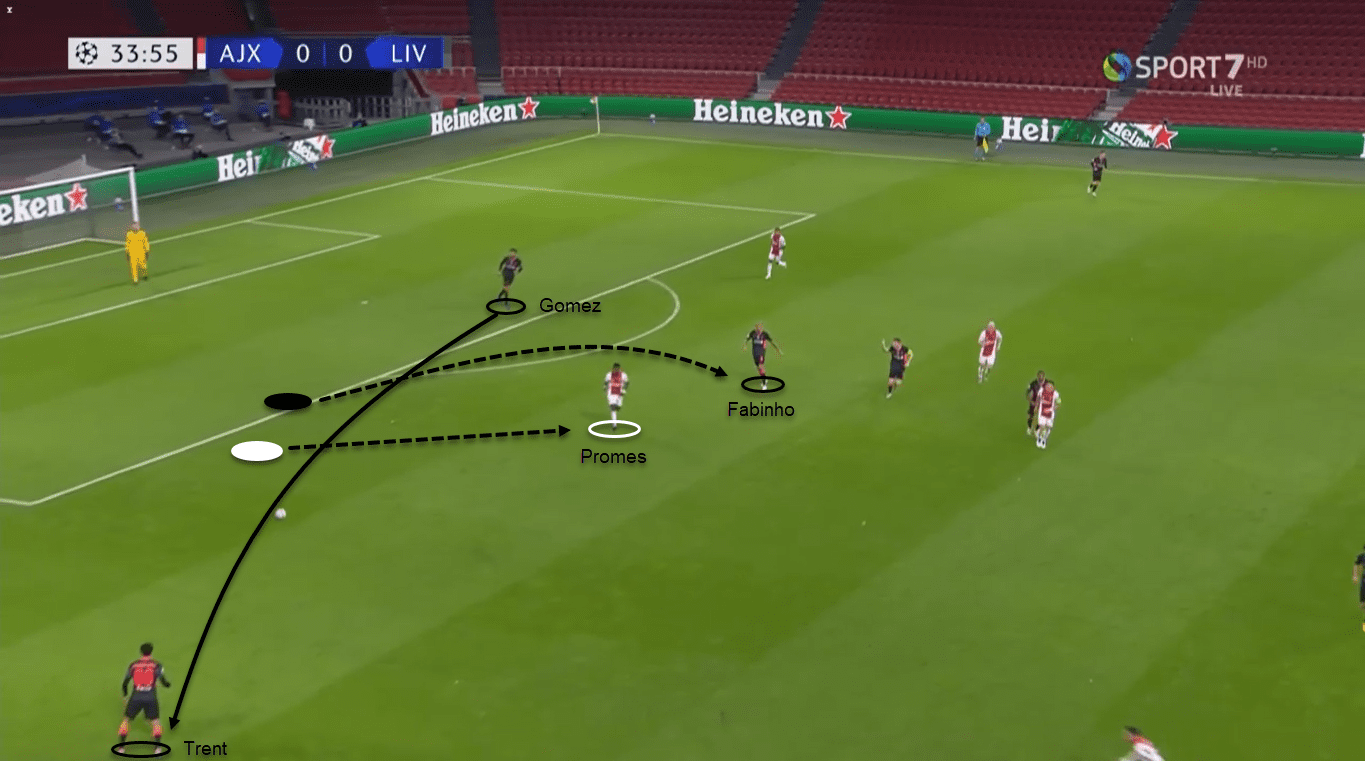
Liverpool players were smart to adapt to the situation and figure out options to work around the press. Fabinho tucked infield to drag Promes in the centre, as the central channel was the priority for Ajax to block. This allowed Gomez to comfortably play ground balls to full-backs without any pressure. The full-backs didn’t push higher in such situations to increase the distance for Tagliafico and Mazraoui to cover. The ground ball was relatively easier to control, hence offering more time to pick the forward pass.
Another solution was to push Robertson and Alexander-Arnold ahead of the half-way line. Then Milner/Jones would occupy their position to collect easy passes. This helped as Klaassen and Gravenberch were not always comfortable in leaving holes in the centre of the pitch, something that the Liverpool forwards could’ve then dropped in to utilise. However, these solutions were only useful to progress the ball until the second phase of the build-up and not any further. This was because of the tight marking on Liverpool’s forwards and Ajax’s forwards and midfield reacting to these situations timely.
After taking the lead in the first half, Liverpool took a cautious approach for the rest of the game. Adrián launched the ball to the furthest player as and when possible, instead of encouraging a play from the back. Liverpool focused on defending the lead and didn’t seem to take any chances with that.
Liverpool’s problems in possession
Creative deficiency
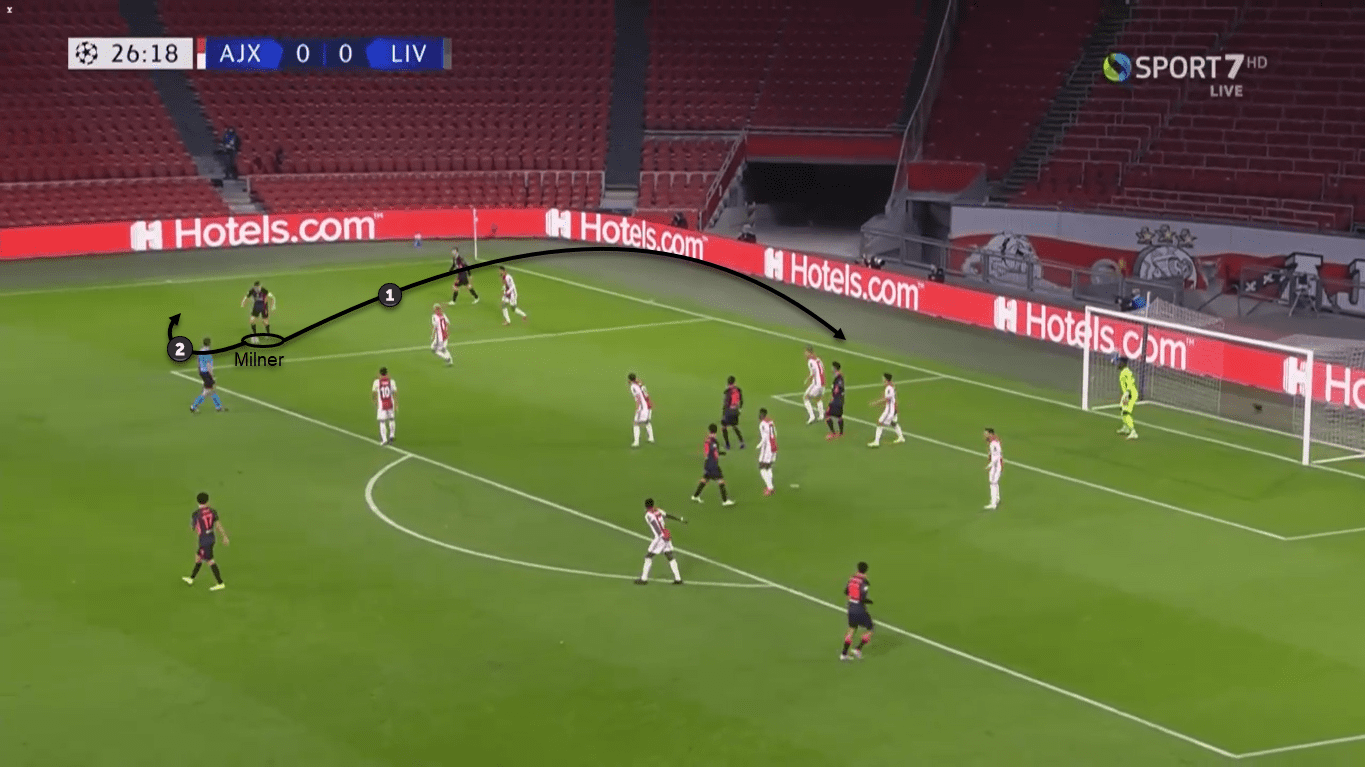
There was a clear lack of service to the front three of Liverpool. The Reds didn’t have the midfield support of Henderson and Thiago for the game. Milner and Jones couldn’t emulate the same level of creativity. Jones was replaced by Henderson at the half-time. Because it came down to decision-making, there were clear instances where the ball should have been played into the box. Instead, the midfielders took a safer option to keep the possession and kept their forwards waiting in the box. Besides Wijnaldum playing a deeper role, there was a lack of penetration in the midfield as well. Looking at the support from the back, Liverpool missed Van Dijk’s long balls in this game. Despite Fabinho having an exquisite passing range, he couldn’t provide the same service.
Along with this, Liverpool had majorly relied on the crosses from their full-backs. Both Alexander-Arnold and Robertson played five crosses collectively, with none of them being accurate. The overall team performance in terms of crosses was a big let-down. They attempted 15 crosses out of which only one was accurate. Due to all these reasons, the front three were left to create chances by themselves. This impacted their performance drastically as both Mané and Salah failed to register a single shot on target. The only goal of the match was also due to the individual brilliance of Mané from a throw-in. His dribbling got him away from his man but his shot was poor. In his luck, Tagliafico turned that shot into his own goal to give Liverpool the lead.
Counter-attacks and corners
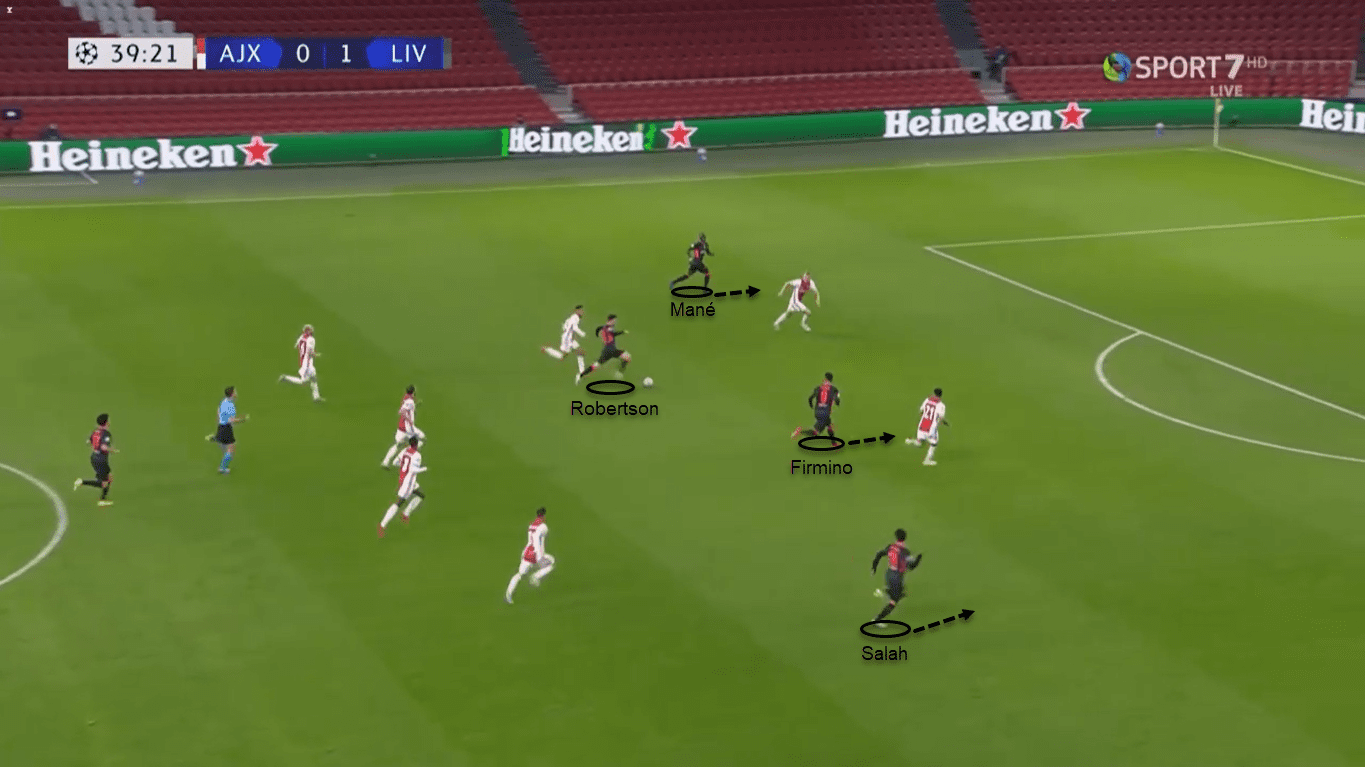
Ajax committed many men forward, leaving no more than three players in rest defence. Thus Liverpool’s best opportunities came from counter-attacks. They were extremely direct and quick after winning the possession, which led to nine counter-attacks in the game. Yet the efficiency was not up to the mark in terms of converting those chances. Ajax players defended with guts and threw their bodies to block the shots on such occasions. Out of the 14 shots attempted by Liverpool, six were blocked by Ajax players. Otherwise, the positional sense of these defenders was clever, as they managed to force a back-pass from the forwards. Liverpool’s best chance from a counter-attack came in the 90th minute of the game. It was then when Onana was tested to save with his legs by Wijnaldum.
The Reds had many opportunities from corners as well. Ajax are not amongst the tallest teams and Liverpool had an advantage up against them. Their corner routine to lose their marker by forming clusters and train was effective. Fabinho and Wijnaldum both had the chance to score from a free header. It seems that things just didn’t fall in place for Liverpool.
Squad depth proving to be vital
Klopp replaced his front three all together by bringing Diogo Jota, Takumi Minamino and Xherdan Shaqiri in the 60th minute. It can be thought as to give them some rest for the weekend game or a massive tactical switch. In either case, it worked out well for them. Mané and Salah used to invert and stayed high when in the possession and were there marked by Ajax’s centre-backs Schuurs and Martínez respectively. This was also the reason why Ajax could allow their full-backs to press Liverpool’s full-backs when they were out of possession. At the same time, Firmino was offered very little breathing space by Blind.

Minamino didn’t employ the same role as Firmino’s false 9, so Blind was either forced back or he could easily get behind his marker. Jota and Shaqiri also operated in a different way as compared to Mané and Salah. They played relatively deeper and helped in ball progression. The centre-backs were unsure to track them all the way and therefore they had a free run at them. They also combined to create overloads on one side to make the man-marking job worse for Ajax. They had a better impact than the former trio in just 30 mins. Shaqiri played two key (most for his team) passes for Liverpool and Minamino attempted two shots on goal with 100% accuracy. Jota attempted six dribbles with 67% efficiency and had a go at the goal twice.
Ajax’s build-up against Liverpool’s press
Use of the middle third in the progression
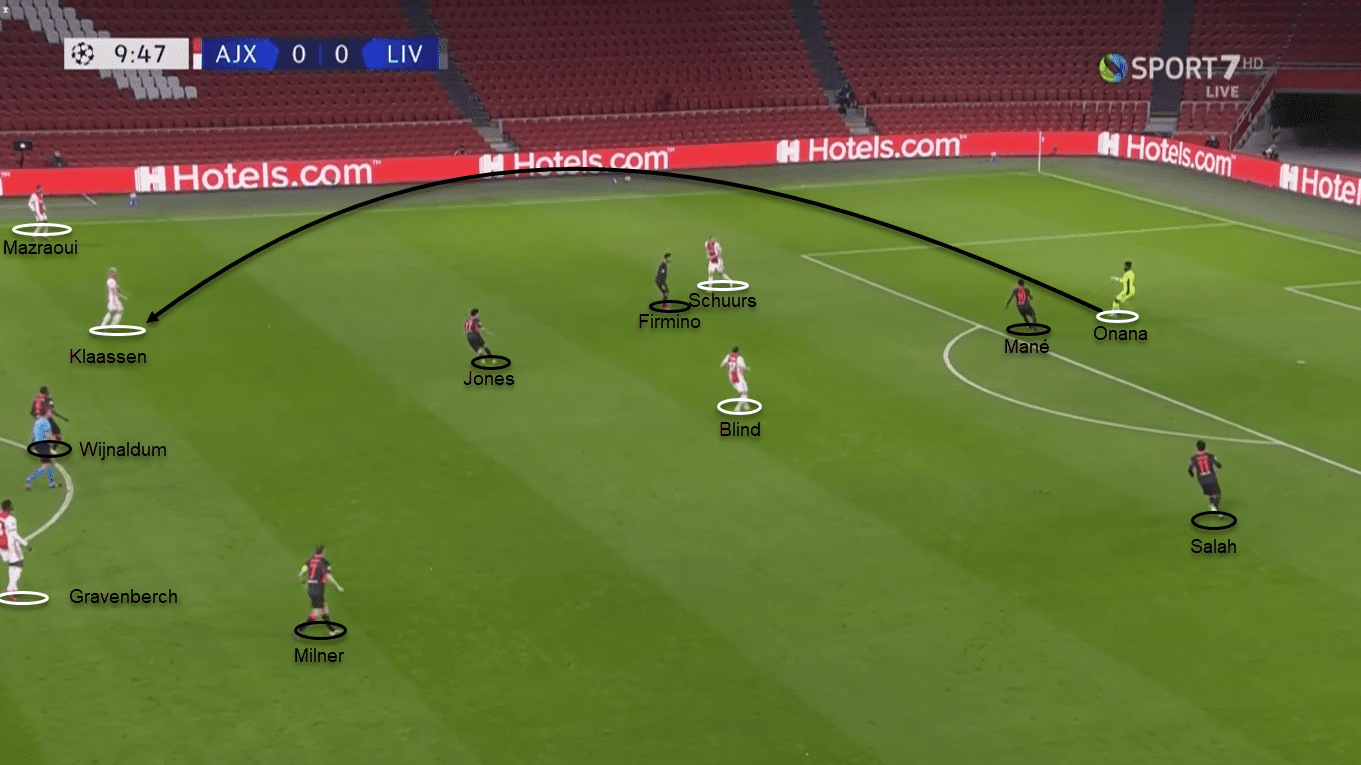
Neres and Promes positioned themselves between the full-backs and centre-backs in the build-up phase. Hence de Godenzonen locked the Liverpool backline and didn’t allow them to join the press easily. Liverpool tried to press in a 4-2-3-1 with Jones moving up close to Blind. This helped them create a 4v4 situation against Ajax in the offensive half. However, Ajax pushed their full-backs to join the midfield alongside Klaassen and Gravenberch. They faced Milner and Wijnaldum in the mid-block. Onana showed immense potency to pick accurate passes to the midfield. Milner and Wijnaldum were slow to shift across and cover the possible receivers. They were also put in a 2v1 situation against the Ajax’s full-back and one of the midfielder. Klopp was raging at the side-lines on seeing how easily Ajax could bypass Liverpool’s press.
Combining through the central corridor
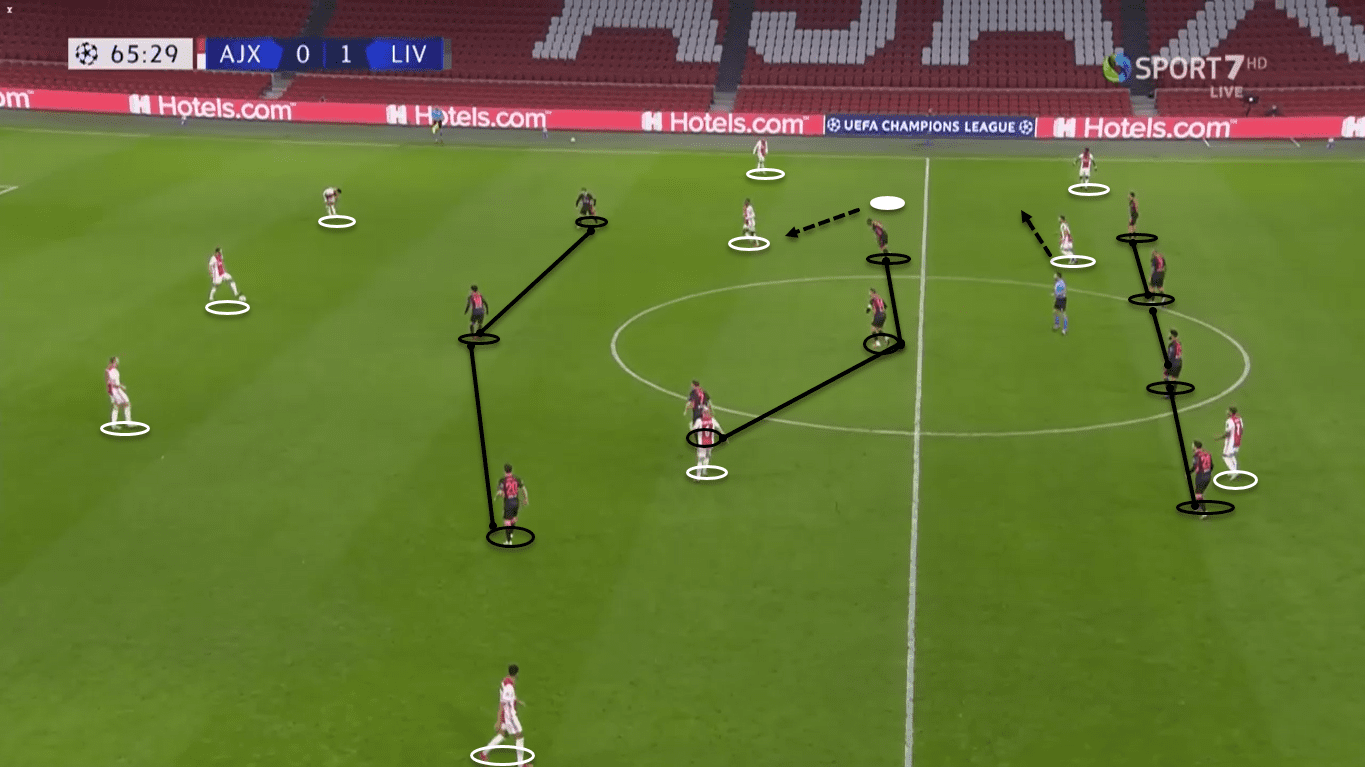
In the second half, the Reds restricted pushing a midfielder up to press Blind. They maintained their 4-3-3 shape while pressing and it would easily change to 4-5-1 once the ball was in the middle third. Ajax’s full-backs were always unmarked with no Liverpool player in proximity to press. Liverpool wingers had to track back and put in the extra yards every time the full-backs received the ball. Therefore, this was always an option for Ajax to move the ball.
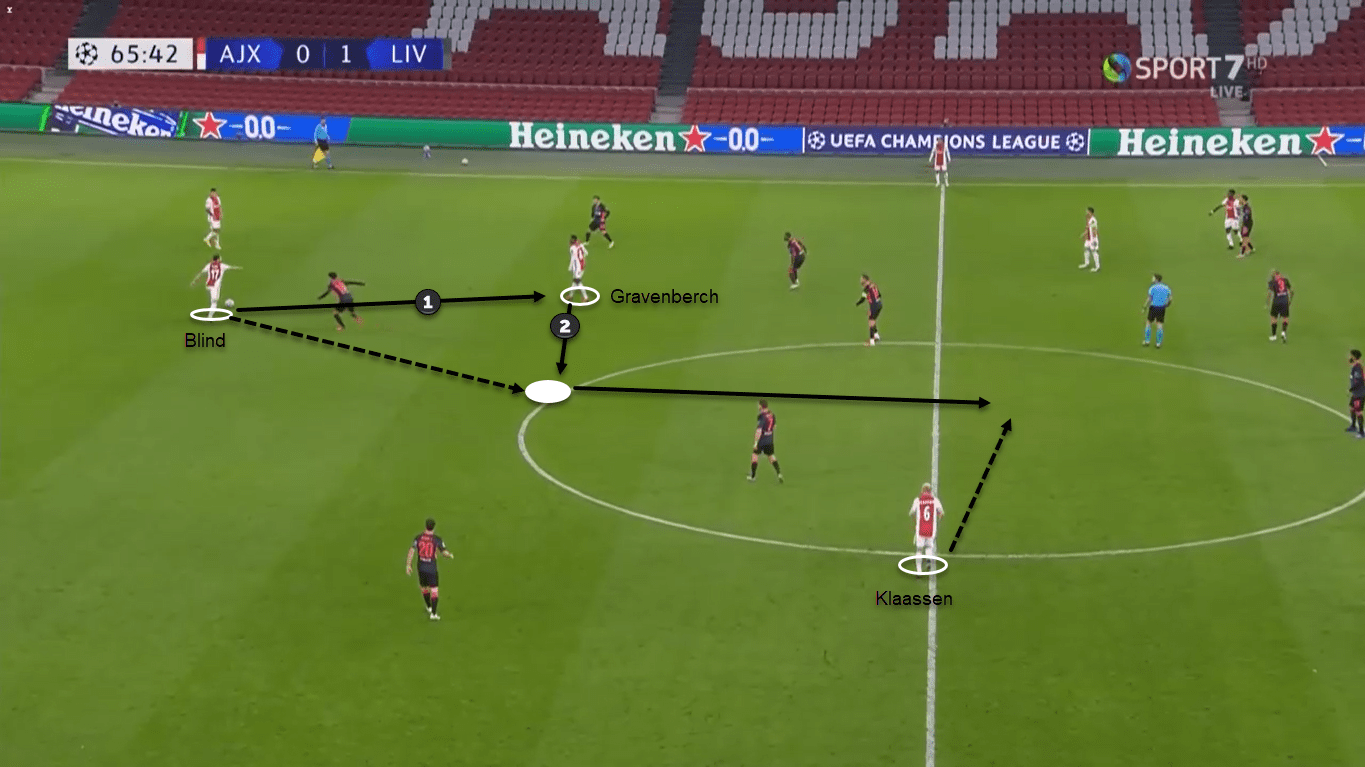
Yet they were persistent in trying to progress from the centre. Credit to Klaassen and Gravenberch’s positioning as either one if not both would try to stay behind Liverpool’s midfield line. They gave Blind a diagonal passing option by playing between the lines. They both showed the ability to receive on the half-turn and quickly progress the play further. If the routes were closed, then one would drop in the centre to combine with Blind to eventually get the ball forward from the centre. On such occasions, Tadić too would drop off in the space vacated by the supporting midfielder making him as a potential passing option. Blind orchestrated the midfield from the back in the build-up.
Ajax’s chances in possession
Narrow attack
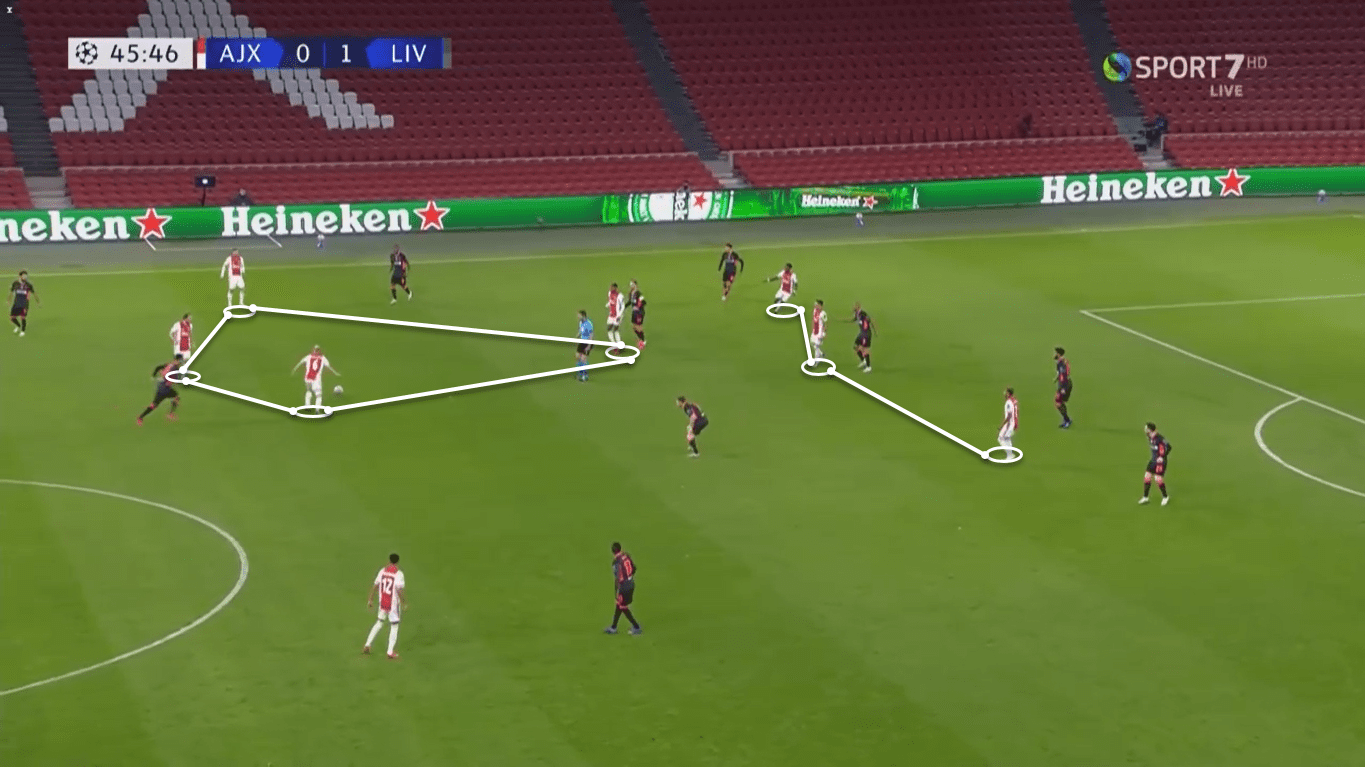
Ajax attack in a relatively compact shape as opposed to the attacking principles. The forwards each occupy a channel between the opposition’s back four. As they like to create their chances by playing through or over the top balls to players running in those channels. The midfielders are joined by the full-backs to overload one side. Tadić is pivotal in laying off passes for midfielders to shoot. Klaassen hit the post from Tadić’s lay off from the outside of the box. Tadić acts as the glue between the two lines. He provided three-shot assists for his teammates.
Liverpool’s defence was well organised and structured. The centre-backs made 21 interceptions collectively to stop Ajax’s inter-play. Despite their attempts to stop the Dutch side as a team, Ajax worked to create enough chances to at least get an equaliser in the game. Through their unpredictability, they created their opportunities.
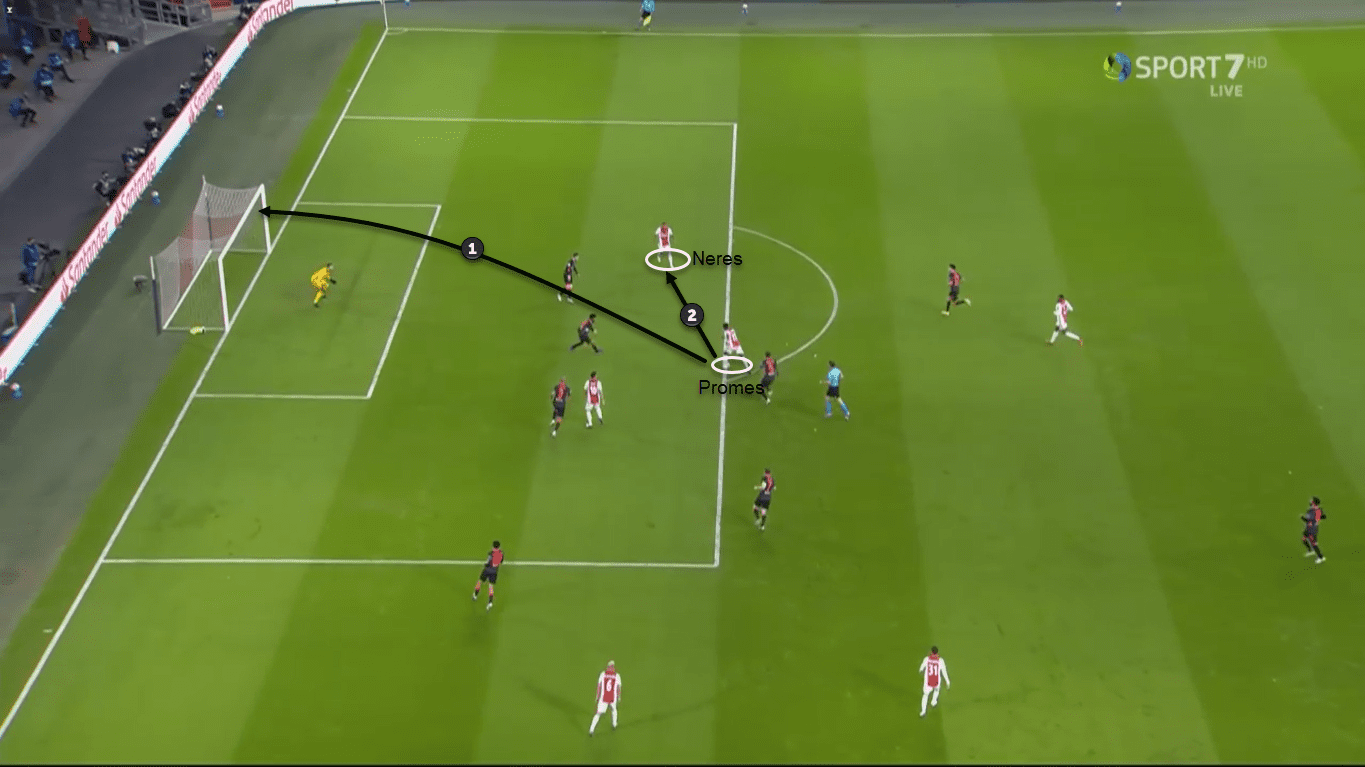
When Promes received a square pass from Klaassen, it appeared he is aiming for the top corner. Gomez was distant from him to close the angle yet he tried to get closer.
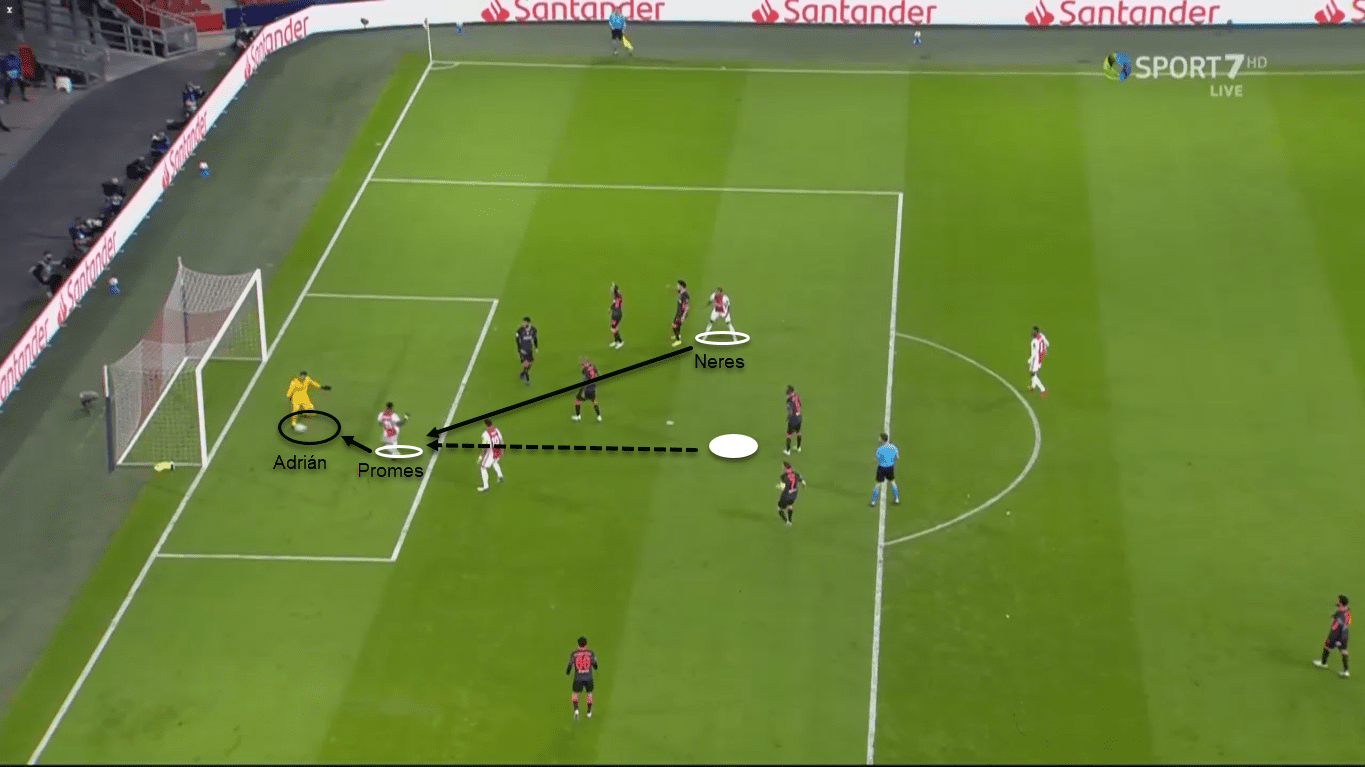
To everyone’s surprise, Promes played a quick one-two with Neres in the tight space and also stayed onside in the process. Adrián made a fantastic reflex save with his leg to deny Promes from the close range. Now some might call it an over-play after seeing the actions of players in the box. But that’s what makes them capable to play in such narrow spaces; this is what defines their style.
Changes in the dying minutes
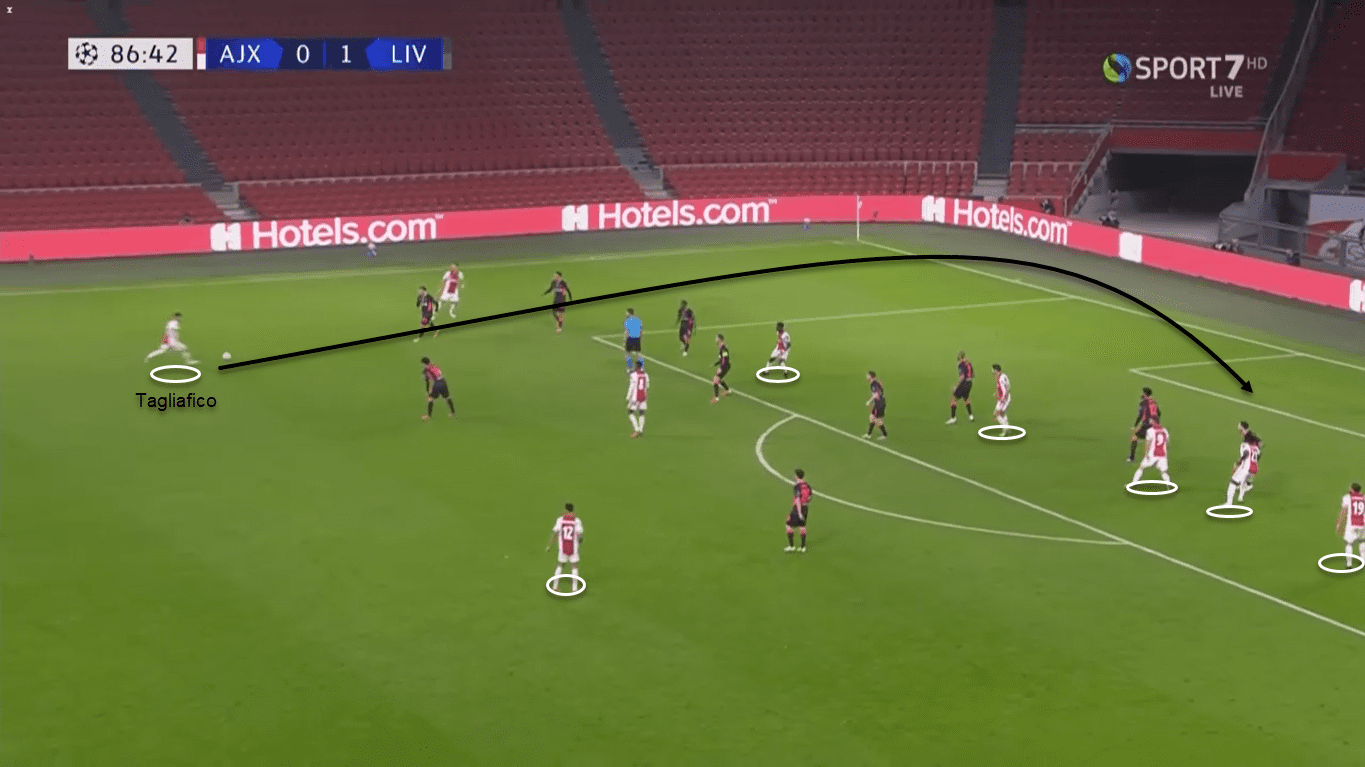
As the clock ticked past a half an hour into the second half, Ajax decided to throw the kitchen sink at Liverpool in search of an equaliser. Jurgen Ekkelenkamp and Zakaria Labyad were subbed in the 74th minute in place of Klaassen and Neres. Blind and Schuurs were replaced by Lassina Traoré and Klaas-Jan Huntelaar in the 84th minute. They switched to an asymmetric 3-4-3 with both Tadić and Labyad playing as wing-backs. The full-backs joined Martínez to form the back three. They played early crosses in the box with at least five players waiting inside to contribute for the team.
Ajax attempted 22 crosses in the game of which 10 came in the last 15 minutes. Ajax didn’t have a strong aerial presence in the box until Huntelaar’s introduction and therefore they struggled to covert those deliveries. Liverpool too sent in the young centre-back Williams to provide extra cover. They survived the last run in the hustle and bustle.
Conclusion
The match was a rare instance to witness Klopp playing for a 1-0. Both sides had a good amount of chances to have produced more drama. Ajax displayed a dynamic performance with a mix of young and experienced players and they deserved more than a loss. Liverpool will gather much confidence from this clean-sheet as they continue to be without their first-choice centre-back and goalkeeper.





Comments